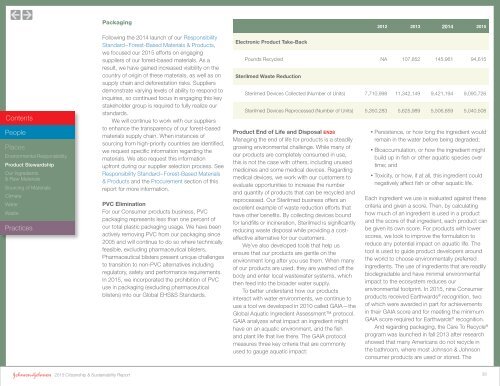People Places Practices
2015-JNJ-Citizenship-Sustainability-Report
2015-JNJ-Citizenship-Sustainability-Report
You also want an ePaper? Increase the reach of your titles
YUMPU automatically turns print PDFs into web optimized ePapers that Google loves.
Packaging<br />
Following the 2014 launch of our Responsibility<br />
Standard–Forest-Based Materials & Products,<br />
we focused our 2015 efforts on engaging<br />
suppliers of our forest-based materials. As a<br />
result, we have gained increased visibility on the<br />
country of origin of these materials, as well as on<br />
supply chain and deforestation risks. Suppliers<br />
demonstrate varying levels of ability to respond to<br />
inquiries, so continued focus in engaging this key<br />
stakeholder group is required to fully realize our<br />
standards.<br />
We will continue to work with our suppliers<br />
to enhance the transparency of our forest-based<br />
materials supply chain. When instances of<br />
sourcing from high-priority countries are identified,<br />
we request specific information regarding the<br />
materials. We also request this information<br />
upfront during our supplier selection process. See<br />
Responsibility Standard–Forest-Based Materials<br />
& Products and the Procurement section of this<br />
report for more information.<br />
PVC Elimination<br />
For our Consumer products business, PVC<br />
packaging represents less than one percent of<br />
our total plastic packaging usage. We have been<br />
actively removing PVC from our packaging since<br />
2005 and will continue to do so where technically<br />
feasible, excluding pharmaceutical blisters.<br />
Pharmaceutical blisters present unique challenges<br />
to transition to non-PVC alternatives including<br />
regulatory, safety and performance requirements.<br />
In 2015, we incorporated the prohibition of PVC<br />
use in packaging (excluding pharmaceutical<br />
blisters) into our Global EHS&S Standards.<br />
Electronic Product Take-Back<br />
Product End of Life and Disposal EN28<br />
Managing the end of life for products is a steadily<br />
growing environmental challenge. While many of<br />
our products are completely consumed in use,<br />
this is not the case with others, including unused<br />
medicines and some medical devices. Regarding<br />
medical devices, we work with our customers to<br />
evaluate opportunities to increase the number<br />
and quantity of products that can be recycled and<br />
reprocessed. Our Sterilmed business offers an<br />
excellent example of waste reduction efforts that<br />
have other benefits. By collecting devices bound<br />
for landfills or incineration, Sterilmed is significantly<br />
reducing waste disposal while providing a costeffective<br />
alternative for our customers.<br />
We’ve also developed tools that help us<br />
ensure that our products are gentle on the<br />
environment long after you use them. When many<br />
of our products are used, they are washed off the<br />
body and enter local wastewater systems, which<br />
then feed into the broader water supply.<br />
To better understand how our products<br />
interact with water environments, we continue to<br />
use a tool we developed in 2010 called GAIA—the<br />
Global Aquatic Ingredient Assessment protocol.<br />
GAIA analyzes what impact an ingredient might<br />
have on an aquatic environment, and the fish<br />
and plant life that live there. The GAIA protocol<br />
measures three key criteria that are commonly<br />
used to gauge aquatic impact:<br />
2012 2013 2014 2015<br />
Pounds Recycled NA 107,852 145,961 94,615<br />
Sterilmed Waste Reduction<br />
Sterilmed Devices Collected (Number of Units) 7,710,998 11,342,149 9,421,194 9,090,726<br />
Sterilmed Devices Reprocessed (Number of Units) 5,350,283 5,625,989 5,506,859 5,040,508<br />
• Persistence, or how long the ingredient would<br />
remain in the water before being degraded;<br />
• Bioaccumulation, or how the ingredient might<br />
build up in fish or other aquatic species over<br />
time; and<br />
• Toxicity, or how, if at all, this ingredient could<br />
negatively affect fish or other aquatic life.<br />
Each ingredient we use is evaluated against these<br />
criteria and given a score. Then, by calculating<br />
how much of an ingredient is used in a product<br />
and the score of that ingredient, each product can<br />
be given its own score. For products with lower<br />
scores, we look to improve the formulation to<br />
reduce any potential impact on aquatic life. The<br />
tool is used to guide product developers around<br />
the world to choose environmentally preferred<br />
ingredients. The use of ingredients that are readily<br />
biodegradable and have minimal environmental<br />
impact to the ecosystem reduces our<br />
environmental footprint. In 2015, nine Consumer<br />
products received Earthwards ® recognition, two<br />
of which were awarded in part for achievements<br />
in their GAIA score and for meeting the minimum<br />
GAIA score required for Earthwards ® recognition.<br />
And regarding packaging, the Care To Recycle ®<br />
program was launched in fall 2013 after research<br />
showed that many Americans do not recycle in<br />
the bathroom, where most Johnson & Johnson<br />
consumer products are used or stored. The<br />
2015 Citizenship & Sustainability Report 38


